Dragon fruit, also known as pitaya, is one of the most visually striking and nutritionally rich fruits in the world. Its vibrant pink or yellow skin, speckled with green scales, and sweet, juicy flesh make it a favorite among fruit lovers and health enthusiasts alike. But have you ever wondered how this exotic fruit is cultivated on farms before reaching your local markets? The process of growing dragon fruit is a fascinating blend of science, patience, and innovation. In this article, we’ll explore the dragon fruit cultivation process step by step, from planting to harvest, and give you a glimpse of life on an amazing dragon fruit farm.
Understanding Dragon Fruit
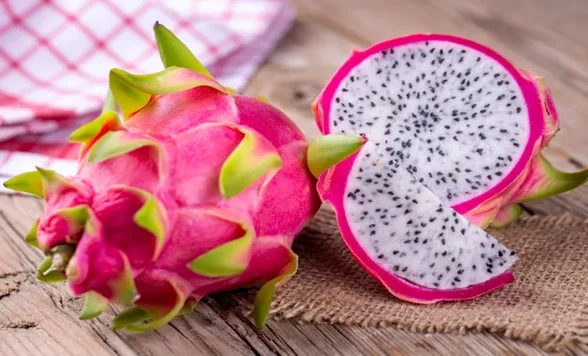
Dragon fruit comes from a type of cactus, most commonly Hylocereus species, which naturally thrives in tropical and subtropical climates. Native to Central America but now widely grown in Southeast Asia, including Vietnam, Thailand, and the Philippines, dragon fruit has quickly gained global popularity.
There are several varieties of dragon fruit:
- Hylocereus undatus – white-fleshed with pink skin
- Hylocereus costaricensis – red-fleshed with pink skin
- Hylocereus megalanthus – white-fleshed with yellow skin
Dragon fruit is not only visually appealing but also packed with nutrients, including antioxidants, vitamin C, fiber, and essential minerals. These health benefits, along with its unique flavor, have increased the demand for dragon fruit worldwide.
Preparing for Cultivation
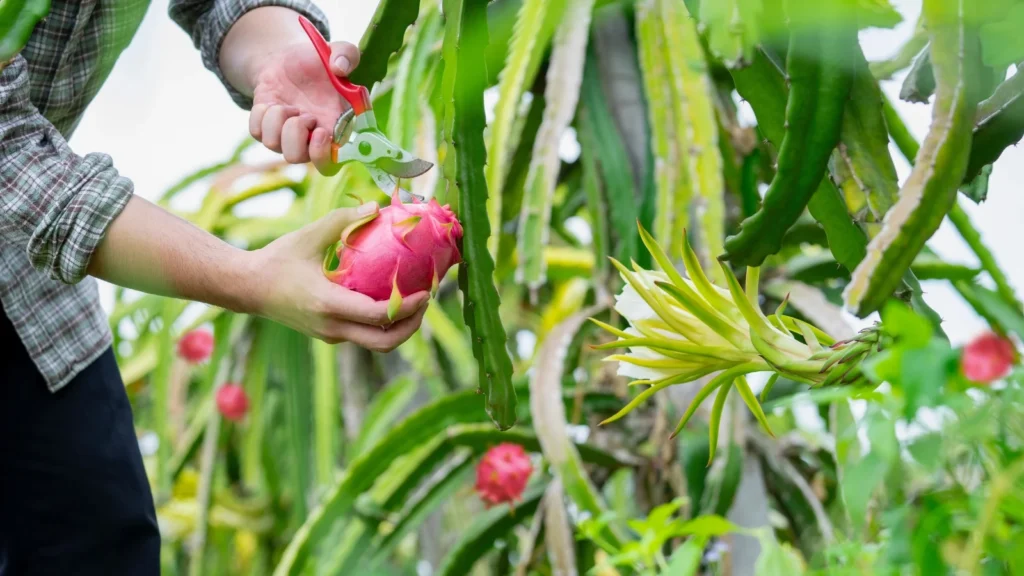
Successful dragon fruit cultivation starts long before planting. Farmers carefully select the variety based on climate, soil, and market demand. The ideal conditions for dragon fruit include:
- Climate: Tropical or subtropical with temperatures between 18–30°C (65–86°F)
- Soil: Well-draining sandy loam with pH between 6 and 7
- Sunlight: Full sun to partial shade, as the plant requires sunlight for flowering and fruiting
Preparation also includes constructing support structures. Since dragon fruit is a climbing cactus, it requires vertical supports such as concrete or wooden posts, or even trellises, to grow upright and allow easy harvesting.
Propagation Methods
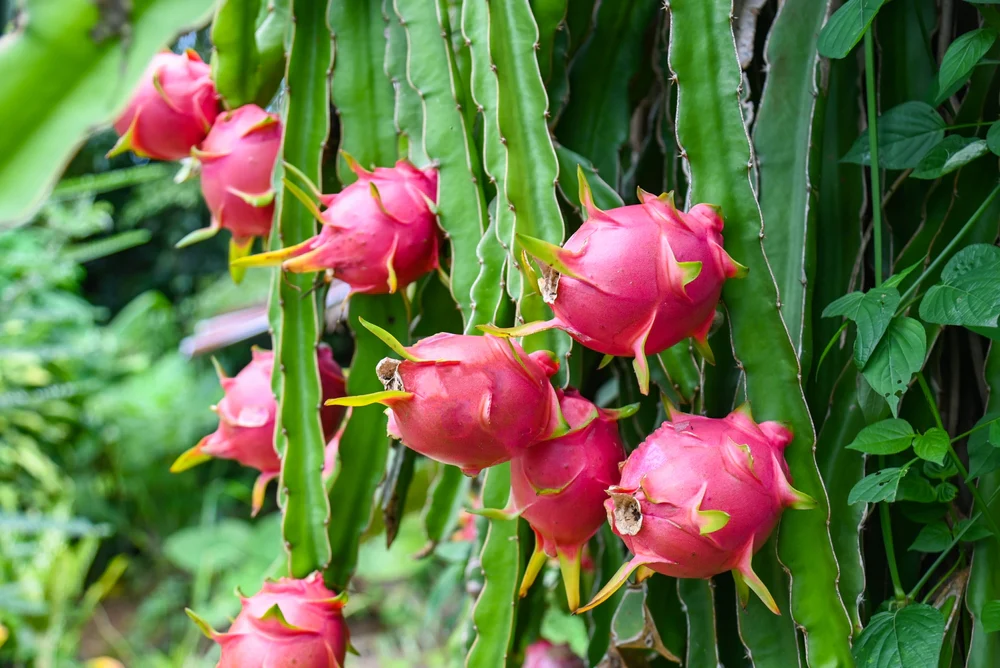
Dragon fruit can be grown either from seeds or cuttings. Each method has its advantages:
- From Seeds:
Growing from seeds is often used for research or experimental purposes. Seeds are extracted from ripe fruit, cleaned, and sown in a well-prepared nursery bed or seed tray. Germination can take 1–4 weeks depending on conditions. Seed-grown plants take longer to mature and bear fruit, often 12–18 months or more. - From Cuttings (Stem Cladodes):
This is the most common commercial method. Healthy, mature stems are cut into segments, allowed to dry for a few days to prevent rot, and then planted directly into soil or nursery beds. Cuttings grow faster than seed-grown plants and typically produce fruit within 6–8 months.
Planting and Nursery Care
Whether grown from seeds or cuttings, young dragon fruit plants are initially nurtured in a nursery to ensure strong growth. Key practices include:
- Soil Preparation: A mix of fertile soil, compost, and sand is used to ensure drainage and nutrition.
- Watering: Regular but moderate watering is essential, as overwatering can cause root rot.
- Pest Management: Young plants are vulnerable to pests like aphids and mealybugs. Farmers often use natural remedies or low-toxicity pesticides to protect them.
- Shading: Nurseries provide shade to protect seedlings from harsh sunlight until they are strong enough to be transplanted.
After several months, when seedlings or cuttings have developed a strong root system, they are ready for transplanting to the main farm.
Field Preparation and Planting
Dragon fruit farms require careful planning. Farmers typically arrange plants in rows along the support structures, ensuring adequate spacing to allow air circulation and sunlight penetration. Proper spacing also facilitates pollination, reduces disease risk, and makes harvesting easier.
- Spacing: Plants are usually spaced 1–2 meters apart, depending on the support system and variety.
- Support Construction: Vertical posts or trellises are installed before transplanting to guide the climbing growth of the cactus.
- Transplanting: Plants are gently removed from the nursery and planted in prepared holes, ensuring the roots are well-covered and soil firmly packed.
Care and Maintenance
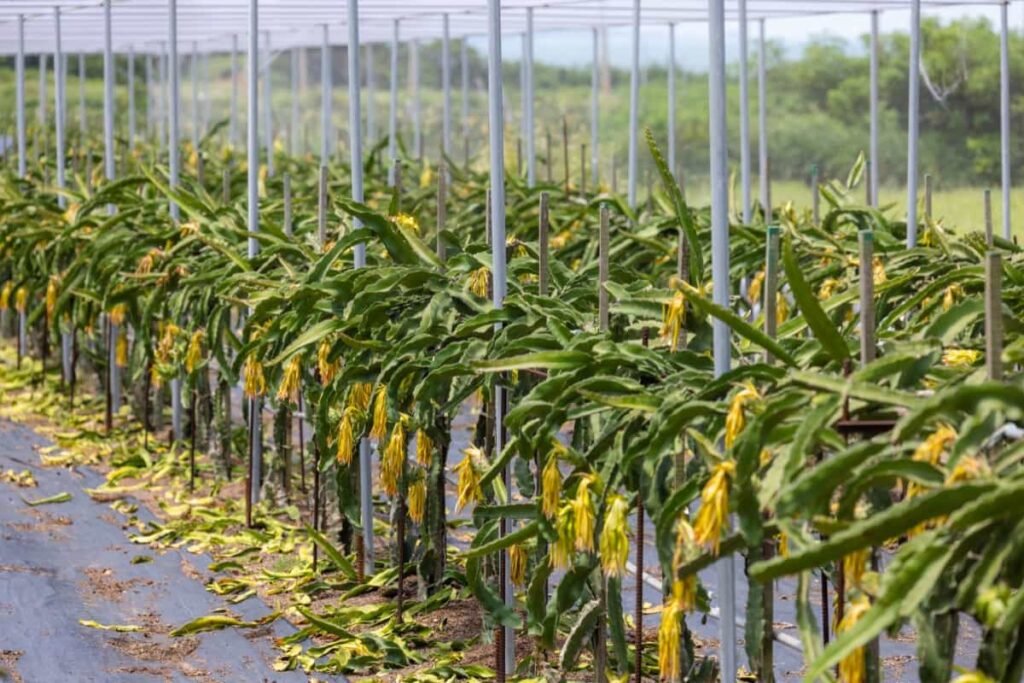
Dragon fruit requires consistent care to thrive and produce high-quality fruits. Some essential maintenance practices include:
- Watering: Deep watering is necessary, especially during flowering and fruiting. Drip irrigation is often used in commercial farms to conserve water and maintain soil moisture.
- Fertilization: Balanced fertilizers rich in nitrogen, phosphorus, and potassium are applied regularly. Organic fertilizers like compost or manure can also improve soil fertility.
- Pruning: Regular pruning helps remove dead or overcrowded stems, improves airflow, and promotes better flowering.
- Pest and Disease Control: Common pests include aphids, ants, and fruit flies. Fungal infections can also occur. Farmers adopt integrated pest management techniques to minimize damage while maintaining plant health.
- Training the Plant: Dragon fruit is a climbing cactus, so guiding stems onto supports and tying them as needed ensures proper growth and prevents stem breakage.
Flowering and Pollination
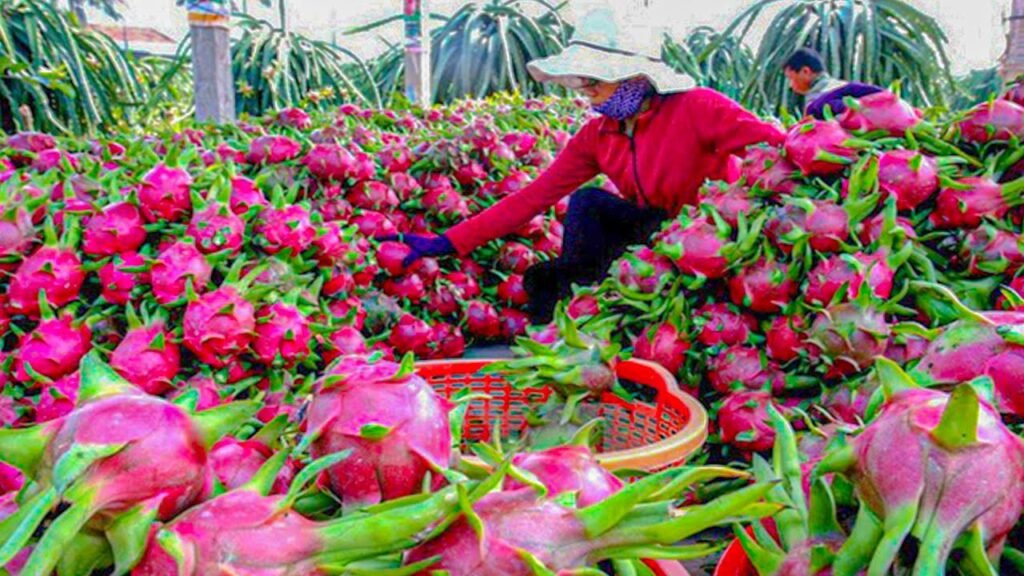
Dragon fruit plants produce stunning, large white flowers, often called “moonflowers” because they bloom at night. Flowering usually occurs during warm months and is critical for fruit production.
- Pollination: While some varieties are self-pollinating, others require cross-pollination. Farmers often use hand pollination to improve fruit set and yield, transferring pollen from the stamen of one flower to the stigma of another using a brush.
- Timing: Flowers bloom at night and may last only one night, making timely pollination essential.
Harvesting Dragon Fruit
After pollination, fruits take about 30–50 days to mature, depending on the variety and growing conditions. Farmers monitor the fruits for color change, size, and firmness as indicators of ripeness.
- Harvesting Method: Fruits are typically harvested by hand using small knives or scissors to cut the stem. Care is taken to avoid damaging the fruit or plant.
- Frequency: Farms may harvest multiple times during the peak season, as fruits ripen at different times.
- Post-Harvest Handling: Harvested fruits are washed, sorted, and packed carefully to prevent bruising. Some are sold fresh in local markets, while others are exported.
Economic and Nutritional Value
Dragon fruit farming is not only visually stunning but also economically rewarding. Its high demand in domestic and international markets provides farmers with a steady income. Moreover, dragon fruit is a nutrient powerhouse, rich in antioxidants, vitamins, and fiber, making it increasingly popular among health-conscious consumers.
Challenges in Dragon Fruit Cultivation
Despite its popularity, growing dragon fruit comes with challenges:
- Climate Sensitivity: Extreme temperatures, heavy rains, or droughts can reduce yield and fruit quality.
- Pest and Disease Pressure: Fungal infections, fruit flies, and stem rot are common issues that require careful management.
- Labor-Intensive Practices: From training the plants on supports to hand-pollination and harvesting, dragon fruit farming demands skilled labor.
Farmers overcome these challenges through careful farm management, modern agricultural practices, and experience gained over years of cultivation.
Conclusion
The journey of dragon fruit from a tiny seed or cutting to a vibrant, delicious fruit is a remarkable story of patience, care, and skill. Through proper cultivation techniques, regular maintenance, and attention to detail, farmers can produce high-quality dragon fruits that delight consumers worldwide. Visiting a dragon fruit farm is a visual and educational experience, revealing not only the beauty of the plants but also the incredible dedication behind every fruit.
Whether you are a home gardener hoping to try growing dragon fruit or simply a fruit enthusiast fascinated by exotic produce, understanding the cultivation process gives a new appreciation for this tropical treasure. Dragon fruit is more than just a beautiful fruit—it’s a testament to agricultural innovation, sustainable farming, and the passion of farmers who nurture it from seed to harvest.
